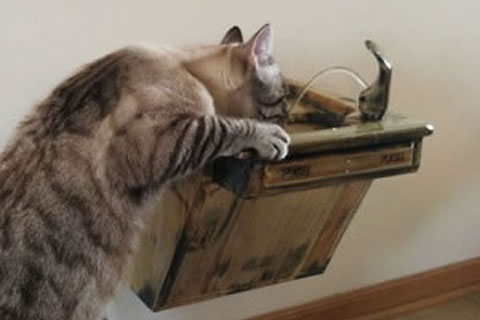Choosing the best cat drinking bowl, fountain, or water dispenser

Note: You can click on any image in the article below to see the actual product on Amazon.com.
Cats need around 4 ounces a day for every 5 pounds of body weight. That's one cup of water per day for an average 10 pound cat.
Cat ancestors adapted as desert hunters to get the water they needed from what they ate. A 10-pound cat can get about half of the water needed for the day from one can of wet food (a can of wet food generally contains about 70% - 80% water).
Dry food is a different story. It generally contains less than 10% moisture, meaning a dry food diet requires more drinking water.
Because cats have a low thirst drive and are not naturally inclined to drink a lot of water they're at a higher risk of dehydration than dogs and other animals. In addition, cats are also more prone to urinary tract infections and other health issues related to dehydration.
The best way to make sure your cat drinks enough water is to make it more appealing. This often has to do with taste, temperature, and attraction to the water source.
Cat Water Bowls
Plastic (especially when scratched) and porous materials allow bacteria a place to cling. This can not only affect taste but can possibly affect health as well. Some plastic bowls can also leave a strange taste in the water due to the chemical makeup of the material used to make the bowl.
Stainless steel and non-porous ceramic/porcelain/glass do a better job of avoiding these problems than porous materials.

The porcelain bowl above is raised for easier drinking, dishwasher safe, and has convenient measuring lines to keep track of your cat's drinking.
Since every situation and cat is different, what's important in keeping track of your cat's drinking is to establish a baseline and notice when your cat is drinking more or less than usual. You can then explore for yourself why there is a difference or follow up with a vet visit if concerned.

The stainless steel bowl above is heavy to avoid tipping over, dishwasher safe, and wide enough with a sloped bottom to avoid whisker stress or fatigue (yes, it's a real thing - watch the video below).
Not all cats are troubled by whisker stress. If your cat's experiencing whisker stress then it may avoid drinking water from the source causing it and look for another source that doesn't cause it.
To avoid whisker stress the water bowl should be wide enough that your cat's whiskers are not pushing up against the edges. You can also make sure the bowl is filled high enough that your cat doesn't have to stick its face deep into the bowl.
Signs of whisker stress can often be seen in how your cat eats. Your cat may paw food out of the bowl, eat from the floor, eat only the food in the center of the bowl, or be hesitant about eating the food in the bowl.
A simple remedy for whisker stress when feeding your cat is to use a wide shallow sloped bottom bowl or to just use a flat dish instead.
Cat Water Fountains
Cat drinking fountains provide two main benefits over a sedentary bowl.
- The running water is appealing to a cat's natural instincts. You may have to give your cat a short time to acclimate to the movement though if used to an ordinary drinking bowl.
- Most fountains filter the water continuously. You'll still need to clean it once in a while but it will be less often than a sedentary bowl.

The stainless steel fountain above holds 74 ounces/2.2 liters of water and has 3-part filtering for better tasting water.

You'll need to clean this unit and replace filters every 2-3 weeks.
If you have more than one pet that will be drinking at the same time then you may want something a little bigger with more than one spout.

The stainless steel fountain above holds 108 ounces/3.2 liters of water, has 4-part filtering for better tasting water and has 2 water streams.

You'll need to clean this unit and replace filters every 2-3 weeks.
Some considerations for a drinking fountain include:
- The pump and some other parts of the fountain may be made of plastic but the bowl (where the water sits) should be made of a non-porous material that doesn't affect the taste (e.g., stainless steel or non-porous ceramic/porcelain).
- The noise can also be annoying to some people and possibly your cat. This noise can come from the pump or the splashing water. A quiet pump and gentle stream reduces the noise.
- Make sure it comes with a pump that's powerful enough. Cheaper fountains may cut costs by using inadequate pumps. Check the product reviews to see if people complain the pump is inadequate.
- When you're considering the cost of a fountain don't forget to factor in the cost of replacement filters and how often they need to be replaced.
Adapt your sink faucet
Some cats prefer drinking from a dripping or running sink faucet. The benefit for your cat is that the water is always fresh. The benefit for you is that you'll never have to clean any bowl or fountain. The trick is to have the water available on demand and not waste water. Click here for an article on two ways you can set up a faucet for your cat to drink from.